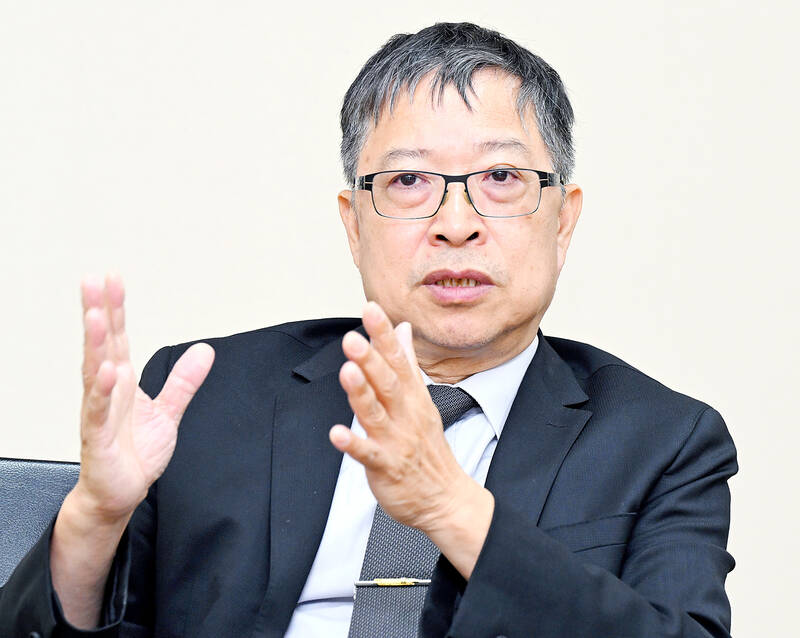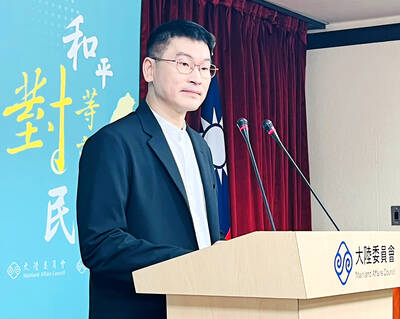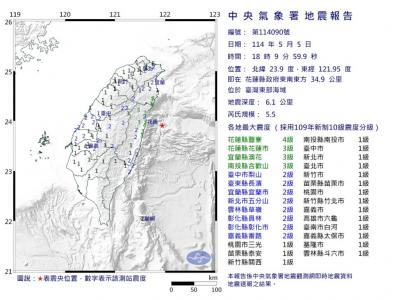Taiwan is likely to eliminate hepatitis C by next year, renowned hepatologist Yu Ming-lung (余明隆) said.
Yu, who is vice president of National Sun Yat-sen University, made the remarks in a recent interview with the Chinese-language Liberty Times (the sister paper of the Taipei Times).
The WHO’s global hepatitis elimination goal is to by 2030 diagnose 90 percent of people with active hepatitis C infections and treat at least 80 percent of them with the aim of curing them.

Photo: Liao Chen-huei, Taipei Times
Taiwan has been accelerating its efforts to eliminate hepatitis C and is on track to reach the WHO’s goal by next year.
Last year, the WHO updated its hepatitis C elimination target, using the 2015 level as a basis for comparison, Yu said.
Under the new target formula, it would only consider those taking direct-acting antivirals as undergoing treatment and would no longer include those taking interferons.
As a result the Health Promotion Administration (HPA) has to recalculate and revise its data, but a preliminary calculation shows that Taiwan is “very likely” to achieve the goal by next year, although some details need to be addressed, Yu said.
The HPA would invite WHO official and experts on hepatitis C to Taiwan toward the end of the year for discussions on changes in the prevalence rate of the virus and the agency’s data processing method, he said.
If the discussions confirm that the government’s direction is correct, it would stay the course, run a statistical analysis in 2026 and officially announce that it had reached its goal, he said.
In the next year and a half, Taiwan needs to achieve two goals, Yu said.
First, it must accelerate screenings of prisoners, with at least 90 percent of inmates receiving a hepatitis C test, he said.
Second, it must increase screenings of people born before 1980, who are eligible for government-funded free health examinations, he said.
Taiwan has about 45,000 to 50,000 prisoners, 30,000 to 40,000 of whom are long-term prisoners, while more than half of all inmates have at one time been a drug addict, which increases their risk of hepatitis C infection, he said.
The most effective method of hepatitis C prevention is to cure those with infections to prevent transmission, so the screening and treatment of prisoners should not be ignored, he said.
If Taiwan can eliminate hepatitis C, the government’s liver disease prevention efforts should then focus on hepatitis B and metabolic dysfunction-associated steatohepatitis (MASH), Yu said.
Regarding hepatitis B, Taiwanese aged 40 and younger were likely vaccinated during infancy and have lower infection risk, so the target group for hepatitis B prevention should be people older than 40, he said.
However, the National Health Insurance-covered drug payment standard for hepatitis B treatment is complicated, making it difficult for patients to access the drug, he said.
The government should simplify the process to prevent people from delaying treatment due to long waits or because they find it too troublesome, he said.
MASH more often occurs in people with obesity, Yu said.
The condition has become one of the main causes of cirrhosis and liver cancer in some European countries and the US, and that as Western diets have become popular, the same situation could be expected to develop in Taiwan in the next 10 years, he said.
Obesity and metabolic syndrome prevention are crucial to avoiding MASH, he said.
If Taiwan can eliminate hepatitis C by next year, it would be the first “non-hepatitis C country” in the world, but it would not be the end of Taiwan’s fight against liver diseases, Yu said.
The challenge of hepatitis B and MASH elimination is also likely to become a decades-long battle, so the HPA’s hepatitis B and hepatitis C prevention office, cross-ministerial collaboration and other government resources would be needed to win that fight, he said.

An essay competition jointly organized by a local writing society and a publisher affiliated with the Chinese Communist Party (CCP) might have contravened the Act Governing Relations Between the People of the Taiwan Area and the Mainland Area (臺灣地區與大陸地區人民關係條例), the Mainland Affairs Council (MAC) said on Thursday. “In this case, the partner organization is clearly an agency under the CCP’s Fujian Provincial Committee,” MAC Deputy Minister and spokesperson Liang Wen-chieh (梁文傑) said at a news briefing in Taipei. “It also involves bringing Taiwanese students to China with all-expenses-paid arrangements to attend award ceremonies and camps,” Liang said. Those two “characteristics” are typically sufficient

A magnitude 5.9 earthquake that struck about 33km off the coast of Hualien City was the "main shock" in a series of quakes in the area, with aftershocks expected over the next three days, the Central Weather Administration (CWA) said yesterday. Prior to the magnitude 5.9 quake shaking most of Taiwan at 6:53pm yesterday, six other earthquakes stronger than a magnitude of 4, starting with a magnitude 5.5 quake at 6:09pm, occurred in the area. CWA Seismological Center Director Wu Chien-fu (吳健富) confirmed that the quakes were all part of the same series and that the magnitude 5.5 temblor was

The brilliant blue waters, thick foliage and bucolic atmosphere on this seemingly idyllic archipelago deep in the Pacific Ocean belie the key role it now plays in a titanic geopolitical struggle. Palau is again on the front line as China, and the US and its allies prepare their forces in an intensifying contest for control over the Asia-Pacific region. The democratic nation of just 17,000 people hosts US-controlled airstrips and soon-to-be-completed radar installations that the US military describes as “critical” to monitoring vast swathes of water and airspace. It is also a key piece of the second island chain, a string of

The Central Weather Administration has issued a heat alert for southeastern Taiwan, warning of temperatures as high as 36°C today, while alerting some coastal areas of strong winds later in the day. Kaohsiung’s Neimen District (內門) and Pingtung County’s Neipu Township (內埔) are under an orange heat alert, which warns of temperatures as high as 36°C for three consecutive days, the CWA said, citing southwest winds. The heat would also extend to Tainan’s Nansi (楠西) and Yujing (玉井) districts, as well as Pingtung’s Gaoshu (高樹), Yanpu (鹽埔) and Majia (瑪家) townships, it said, forecasting highs of up to 36°C in those areas